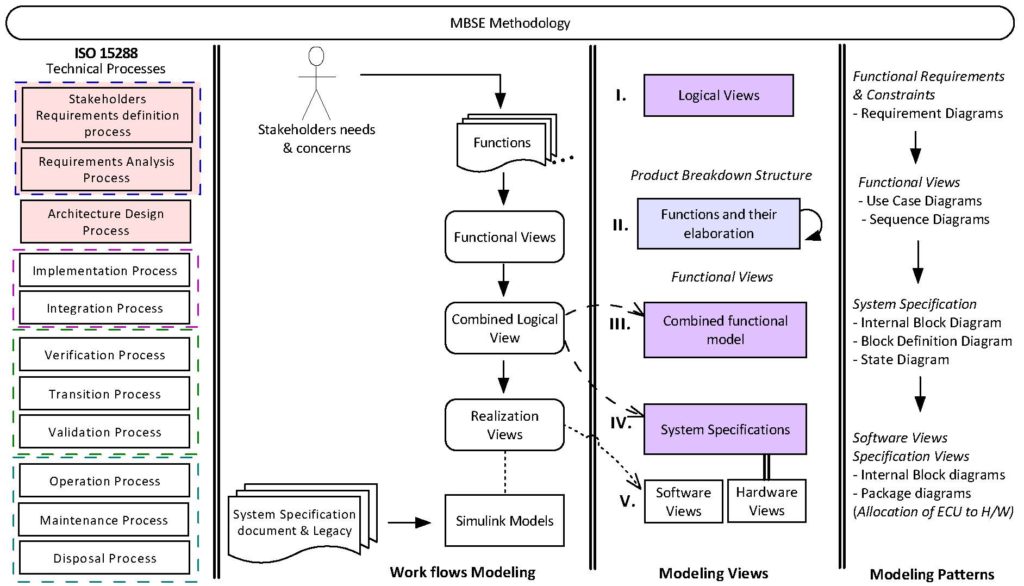Model-based methodologies such as Model-based Systems Engineering (MBSE) and Model-based Design (MBD) are industry-wide being considered as effective solutions in addressing ongoing technological shifts and related development challenges.
In recent times, there has been a significant paradigm shift at Volvo (Construction Equipment) [1] in terms of introducing new technologies such as electromobility, increased automation etc. For instance, electrification (i.e. battery-powered parts) is being introduced into products e.g. hydraulic motors are being replaced with electric versions, new versions of drive-line system (DLS) where electrified hub motors (instead of torque power from the engine) are introduced into wheels. The advanced technological changes described above in large complex products causes enormous challenges for existing software development teams. While the functionality remains largely unchanged in comparison with legacy systems and software, the new design concepts lead to major changes in hardware and software. Hence the traditional function development techniques largely based on small incremental changes to existing software is no longer valid and may lead to quality issues as well as maintainability, traceability problems.
At VCE as well, MBSE [2], MBD [3] and MBT [4] methodologies are currently being experimented and developed. We, students and researchers from Mälardalen University in Sweden with Volvo system engineers are working towards:
- the possibility of applying MBT approaches in order to improve the current testing processes
- investigating the application of an existing MBD methodology to develop a new transmission system (partially electrified) with the goal to see whether it helps in maintaining the traceability between the developed SysML models and existing Simulink models for both hardware and software components.
Adopting MBSE in VCE: we have investigated 1 – how the MBSE methodology was initially conceived (refer Figure 1), 2 – applied in an ongoing project, 3 – the experience of the system engineers towards MBSE and 4 – the lessons learned and challenges faced in applying the methodology. The success or failure of the adopted MBSE methodology is analyzed on the basis of the validation criteria identified from the state-of-art, standards (ISO 15288 [5], ISO 42010 [6]) and best practices. Various stakeholders such as system engineers, function leaders, architects, as well as verification leaders were interviewed and their responses were evaluated based on the formulated validation criteria.
Overall, we found that the methodology developed is properly customized to the specific needs of the development teams at VCE, captures the artifacts corresponding to legacy systems and software, as well as it follows the general principles and guidelines of SE practices.

Figure 1. Methodology Overview: Architecture & Modeling Patterns
Model-based Testing (MBT) approach is introduced to facilitate the automated generation of test cases at the system-level. The purpose is to generate test cases out of requirements models (improve consistency and quality of test cases, and accelerate the generation of test cases), and overall improve the V&V process. Conformiq Creator (CONFORMIQ [7]) has been used for the creation of SysML models and automated generation of test cases. The results of these investigations revealed that the initial results are “satisfactory” and generated enough interest of the concerned testing group, exhaustive analysis of the effectiveness and efficacy of the test cases, especially using both qualitative and quantitative techniques is still part of the ongoing work.
Model-based Design (MBD) approach facilitates to capture the functional behaviour of both the problem (as seen externally) and the solution domain (implementation independent) perspectives. The SysML-based solution models are further refined into Hardware and Software “views” explicitly reflecting the overall design concept(s) being considered, paving the way for traceable software architecture(s) which in turn implemented using traditional Simulink techniques. Our initial investigations suggested that applied SysML-based modelling primarily a reverse-engineering effort in capturing functionality from legacy concepts and corresponding implementations in the hardware and software (in the context of the Transmission System). However, the to be extended into a useful modelling approach complementary to existing software development approaches at VCE.
All these methodologies are under investigations and we are working towards applying them to different projects to draw some concrete conclusions in the future.
References:
- Volvo Construction Equipments AB, Sweden, https://www.volvoce.com/
- Estefan, J. 2015. MBSE Methodology Survey.INSIGHT 12(4), 16–18 (2015)
- Friedenthal, S., Griego, R., Sampson, M.: INCOSE model-based systems engineering (MBSE) initiative. In: INCOSE 2007 Symposium (2007)
- Schieferdecker, I.: Model-based testing. IEEE Software 29(1), 14–18 (Jan 2012)
- ISO 51288, https://www.iso.org/standard/63711.html
- ISO 42010, https://standards.ieee.org/findstds/standard/42010-2011.html
- Conformiq, https://www.conformiq.com/

Saurabh is a Postdoc Researcher at Mälardalen University, (Sweden) and working with Volvo Construction Equipments in Model-Based System Engineering area. He earned his Master’s from NIT, Allahabad (India) in 2010, and the PhD from Indian Institute of Information Technology, Jabalpur (India) in 2016. His current research interests are in the area of Requirements Engineering, Empirical Software Engineering, and Model-based Systems Engineering. He has also received the best paper award at 20th APSEC 2013 conference, and his PhD thesis is indexed in ACM SIGSOFT list of PhD Dissertations in the area of Software Engineering (2016).

